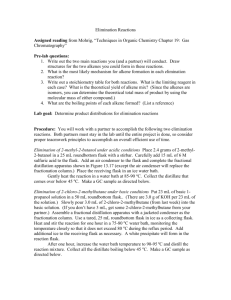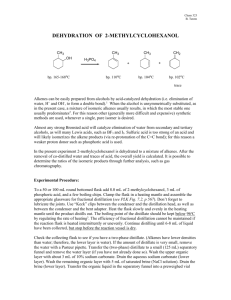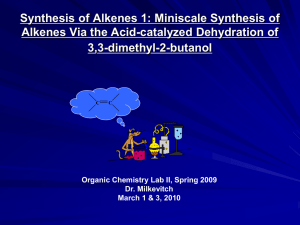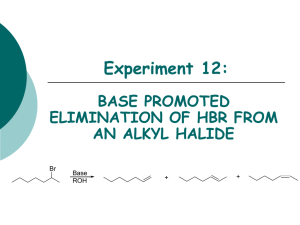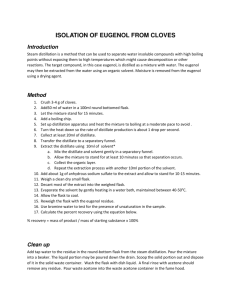CHEM 31 Lab 5 Preparation of an Alkene In this experiment you will
advertisement
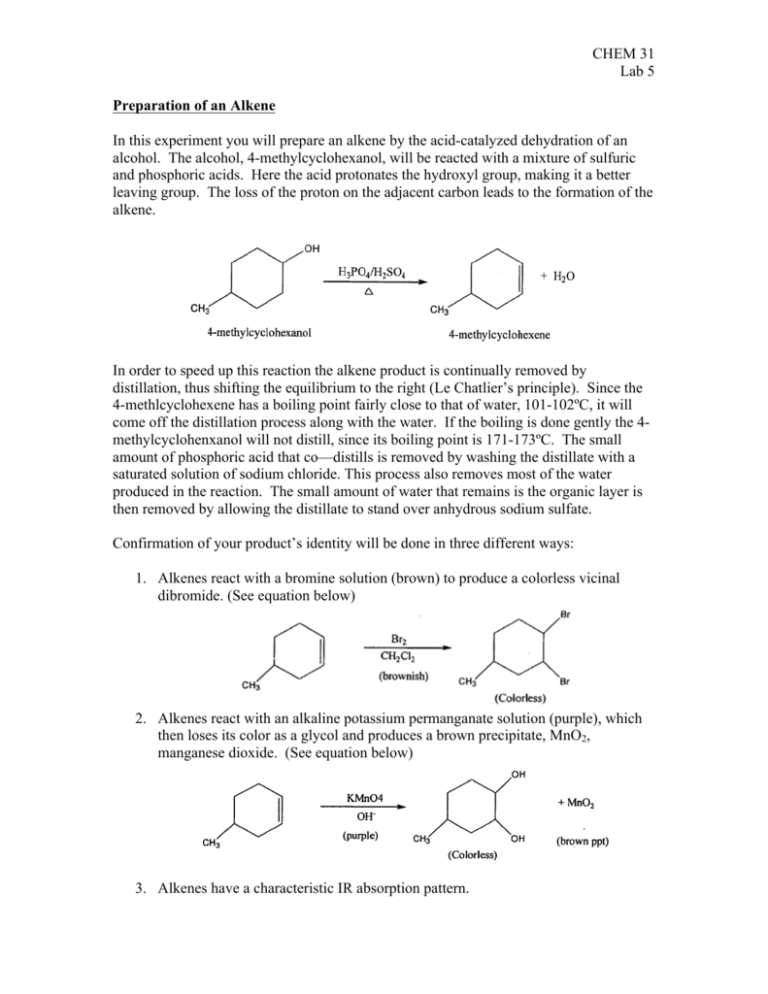
CHEM 31 Lab 5 Preparation of an Alkene In this experiment you will prepare an alkene by the acid-catalyzed dehydration of an alcohol. The alcohol, 4-methylcyclohexanol, will be reacted with a mixture of sulfuric and phosphoric acids. Here the acid protonates the hydroxyl group, making it a better leaving group. The loss of the proton on the adjacent carbon leads to the formation of the alkene. In order to speed up this reaction the alkene product is continually removed by distillation, thus shifting the equilibrium to the right (Le Chatlier’s principle). Since the 4-methlcyclohexene has a boiling point fairly close to that of water, 101-102ºC, it will come off the distillation process along with the water. If the boiling is done gently the 4methylcyclohenxanol will not distill, since its boiling point is 171-173ºC. The small amount of phosphoric acid that co—distills is removed by washing the distillate with a saturated solution of sodium chloride. This process also removes most of the water produced in the reaction. The small amount of water that remains is the organic layer is then removed by allowing the distillate to stand over anhydrous sodium sulfate. Confirmation of your product’s identity will be done in three different ways: 1. Alkenes react with a bromine solution (brown) to produce a colorless vicinal dibromide. (See equation below) 2. Alkenes react with an alkaline potassium permanganate solution (purple), which then loses its color as a glycol and produces a brown precipitate, MnO2, manganese dioxide. (See equation below) 3. Alkenes have a characteristic IR absorption pattern. CHEM 31 Lab 5 Note: Phosphoric and Sulfuric Acids are very corrosive. If either acid should get on your skin it should be immediately washed off with large amounts of water. Also, waste chemicals must never be discarded down the drain or into a wastebasket. Designated waste containers are around the lab, usually under the fume hoods. Procedure Assemble your distillation apparatus as shown in the set-up in the front of the laboratory. From a 10mL graduated cylinder, pour 7.5mL of 4-methylcyclohenanol into a preweighed 50mL round bottom flask and reweigh the flask to determine the weight of the alcohol. Add to the flask 2.0mL of 80% phosphoric acid and 30 drops of concentrated sulfuric acid. Mix the liquids thoroughly with a glass-stirring rod and add a boiling stone. Attach the flask to the distillation apparatus and place a 25mL receiving flask into a ice-water bath to minimize the possibility of the alkene product evaporating into he air of the laboratory. Slowly start the cooling water to flow into the bottom of the condenser and heat the mixture with a heating mantle. The mixture should boil and the distillate should begin to flow into the receiving flask, drop-by-drop. The heat should be regulated so that the entire distillation process does not take less than 30 minutes. When there is no more liquid in the distillation flask the receiving flask should contain mostly 4methylcyclohexene and water. Transfer the distillate to a test tube that can contain the entire product and add 1.5mL of saturated sodium chloride solution to the test tube. Allow the two layers to separate and remove the lower aqueous layer with a Pasture pipette. You may discard the lower layer. Using another dry Pasture pipette, transfer the organic layer to a small Erlenmeyer flask containing a small amount of granular anhydrous sodium sulfate. Stopper the flask and allow it to sit for 15 minutes so that the sodium sulfate can absorb any remaining water in the product. While you are waiting, wash and dry the distillation apparatus using a small amount of acetone for drying. An air stream from your bench-top valve may be used to speed drying. You are now going to perform a final purification of your product by distillation. Pour the dried product into a the clean, dry 50mL round bottom flask while leaving behind as much of the solid sodium sulfate as possible. Add a boiling stone to the flask and assemble the distillation apparatus as before. Precisely weigh the empty receiving flask and place it into a ice-water bath so that the volatile 4-methylcyclohexene does not evaporate into the room. Heat the distillation flask with the heating mantle and collect only the portion of the distillate that boils between 100ºC and 105ºC. Now reweigh the collection flask to determine the weight of your product and calculate the percent yield of your reaction. In the instrument room, run an IR of your 4-methylcyclhexene. This must be done quickly because the alkene evaporates very fast. Note the two or three peaks on the spectrum that are indicative of the alkene product and mark these on the graph. CHEM 31 Lab 5 Unsaturation Tests In a test tube rack, place 5 drops of 4-methylcyclohexanol in each of the two small test tubes. In each of the two small test tubes, place 5 drops of your product, 4methylcyclohexene. Remember which test tubes are which. Take one test tube from each pair and add, drop by drop, a solution of bromine dissolved in methylene chloride, CH2Cl2. Count the drops added and continue to add until the brown color of the bromine no longer disappears. Record the results in each case. To the other two test tubes add a few drops of aqueous, basic permanganate. Since the permanganate solution is not miscible with the organic product, several drops of 1,2-dimethyloxyethane should be added to each of the two tubes before the test is performed. Observe, explain and record the results.




